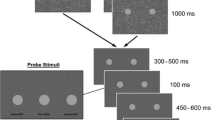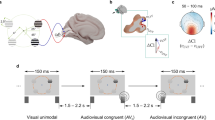Abstract
Background
The development of a visual prosthesis has been limited by an incomplete understanding of functional changes of the visual cortex accompanying deafferentation. In particular, the role of the corpus callosum in modulating these changes has not been fully evaluated. Recent experimental evidence suggests that through synaptic modulation, short-term (4–5 days) visual deafferentation can induce plastic changes in the visual cortex, leading to adaptive enhancement of residual visual input. We therefore investigated whether a compensatory rerouting of visual information can occur via the indirect transcallosal linkage after deafferentation and the influence of this interhemispheric communication on the visual evoked response of each hemisphere.
Methods
In albino rabbits, misrouting of uncrossed optic fibres reduces ipsilateral input to a negligible degree. We thus took advantage of this congenital anomaly to model unilateral cortical and ocular deafferentation by eliminating visual input from one eye and recorded the visual evoked potential (VEP) from the intact eye.
Results
In keeping with the chiasmal anomaly, no VEP was elicited from the hemisphere ipsilateral to the intact eye. This remained unchanged following unilateral visual deafferentation. The amplitude and latency of the VEP in the fellow hemisphere, however, were significantly decreased in the deafferented animals.
Conclusion
Our data suggest that callosal linkage does not contribute to visual evoked responses and this is not changed after short-term deafferentation. The decrease in amplitude and latency of evoked responses in the hemisphere ipsilateral to the treated eye, however, confirms the facilitatory role of callosal transfer. This observation highlights the importance of bicortical stimulation in the future design of a cortical visual prosthesis.





Similar content being viewed by others
References
Dobelle WH (2000) Artificial vision for the blind by connecting a television camera to the visual cortex. Asaio J 46:3–9
Lindvall O, Kokaia Z, Martinez-Serrano A (2004) Stem cell therapy for human neurodegenerative disorders-how to make it work. Nat Med 10(Suppl):S42–S50
Hunt DW, Margaron P (2003) Status of therapies in development for the treatment of age-related macular degeneration. IDrugs 6:464–469
Harvey AR, Hu Y, Leaver SG, Mellough CB, Park K, Verhaagen J, Plant GW, Cui Q (2006) Gene therapy and transplantation in CNS repair: the visual system. Prog Retin Eye Res 25:449–489
Loeb GE (1990) Cochlear prosthetics. Annu Rev Neurosci 13:357–371
Long DM (1977) Electrical stimulation for the control of pain. Arch Surg 112:884–888
Koller W, Pahwa R, Busenbark K, Hubble J, Wilkinson S, Lang A, Tuite P, Sime E, Lazano A, Hauser R et al (1997) High-frequency unilateral thalamic stimulation in the treatment of essential and parkinsonian tremor. Ann Neurol 42:292–299
Brindley GS, Lewin WS (1968) The sensations produced by electrical stimulation of the visual cortex. J Physiol 196:479–493
Zrenner E (2002) Will retinal implants restore vision? Science 295:1022–1025
Weiland JD, Humayun MS (2006) Intraocular retinal prosthesis. Big steps to sight restoration. IEEE Eng Med Biol Mag 25:60–66
Fernandez E, Pelayo F, Romero S, Bongard M, Marin C, Alfaro A, Merabet L (2005) Development of a cortical visual neuroprosthesis for the blind: the relevance of neuroplasticity. J Neural Eng 2:R1–R12
Lickey ME, Pham TA, Gordon B (2004) Swept contrast visual evoked potentials and their plasticity following monocular deprivation in mice. Vision Res 44:3381–3387
Sawtell NB, Frenkel MY, Philpot BD, Nakazawa K, Tonegawa S, Bear MF (2003) NMDA receptor-dependent ocular dominance plasticity in adult visual cortex. Neuron 38:977–985
Hubel DH, Wiesel TN (1970) The period of susceptibility to the physiological effects of unilateral eye closure in kittens. J Physiol 206:419–436
Aboitiz F, Montiel J (2003) One hundred million years of interhemispheric communication: the history of the corpus callosum. Braz J Med Biol Res 36:409–420
Yinon U, Hammer A, Podell M (1982) The hemispheric dominance of cortical cells in the absence of direct visual pathways. Brain Res 232:187–190
Podell M, Yinon U, Hammer A (1984) Properties of visual cortical cells of the intact and the deafferented hemisphere of unilateral optic tract sectioned acute and chronic adult cats. Exp Brain Res 55:91–96
Choudhury BP (1987) Visual cortex in the albino rabbit. Exp Brain Res 66:565–571
Yamauchi Y, Franco LM, Jackson DJ, Naber JF, Ziv RO, Rizzo JF, Kaplan HJ, Enzmann V (2005) Comparison of electrically evoked cortical potential thresholds generated with subretinal or suprachoroidal placement of a microelectrode array in the rabbit. J Neural Eng 2:S48–S56
Sakaguchi H, Fujikado T, Fang X, Kanda H, Osanai M, Nakauchi K, Ikuno Y, Kamei M, Yagi T, Nishimura S et al (2004) Transretinal electrical stimulation with a suprachoroidal multichannel electrode in rabbit eyes. Jpn J Ophthalmol 48:256–261
Houzel JC, Carvalho ML, Lent R (2002) Interhemispheric connections between primary visual areas: beyond the midline rule. Braz J Med Biol Res 35:1441–1453
Silveira LC, Heywood CA, Cowey A (1989) Direct and transcallosal contribution to the cortical visual evoked response in rats. Behav Brain Res 31:291–294
Sanderson KJ (1975) Retinogeniculate projections in the rabbits of the albino allelomorphic series1. J Comp Neurol 159:15–27
Lund RD, Lund JS, Wise RP (1974) The organization of the retinal projection to the dorsal lateral geniculate nucleus in pigmented and albino rats. J Comp Neurol 158:383–403
Sun JS, Li B, Ma MH, Diao YC (1994) Transcallosal circuitry revealed by blocking and disinhibiting callosal input in the cat. Vis Neurosci 11:189–197
Eason RG, Oden D, White CT (1967) Visullay evoked cortical potentials and reaction time in relation to site of retinal stimulation. Electroencephalogr Clin Neurophysiol 22:313–324
Osaka N, Yamamoto M (1978) VEP latency and RT as power functions of luminance in the peripheral visual field. Electroencephalogr Clin Neurophysiol 44:785–788
West DC, Wolstencroft JH (1983) Strength-duration characteristics of myelinated and non-myelinated bulbospinal axons in the cat spinal cord. J Physiol 337:37–50
Brummer SB, McHardy J, Turner MJ (1977) Electrical stimulation with Pt electrodes: Trace analysis for dissolved platinum and other dissolved electrochemical products. Brain Behav Evol 14:10–22
Cowey A, Walsh V (2000) Magnetically induced phosphenes in sighted, blind and blindsighted observers. Neuroreport 11:3269–3273
Gothe J, Brandt SA, Irlbacher K, Roricht S, Sabel BA, Meyer BU (2002) Changes in visual cortex excitability in blind subjects as demonstrated by transcranial magnetic stimulation. Brain 125:479–490
Schmidt EM, Bak MJ, Hambrecht FT, Kufta CV, O’Rourke DK, Vallabhanath P (1996) Feasibility of a visual prosthesis for the blind based on intracortical microstimulation of the visual cortex. Brain 119 ( Pt 2):507–522
Dobelle WH, Mladejovsky MG (1974) Phosphenes produced by electrical stimulation of human occipital cortex, and their application to the development of a prosthesis for the blind. J Physiol 243:553–576
Author information
Authors and Affiliations
Corresponding author
Additional information
The authors have no financial relationship with any organisation concerning this research project. The authors have full control of all primary data and we agree to allow Graefe’s Archive for Clinical and Experimental Ophthalmology to review our data upon request.
Rights and permissions
About this article
Cite this article
Siu, T.L., Morley, J.W. Influence of callosal transfer on visual cortical evoked response and the implication in the development of a visual prosthesis. Graefes Arch Clin Exp Ophthalmol 245, 1797–1803 (2007). https://doi.org/10.1007/s00417-007-0648-8
Received:
Revised:
Accepted:
Published:
Issue Date:
DOI: https://doi.org/10.1007/s00417-007-0648-8




